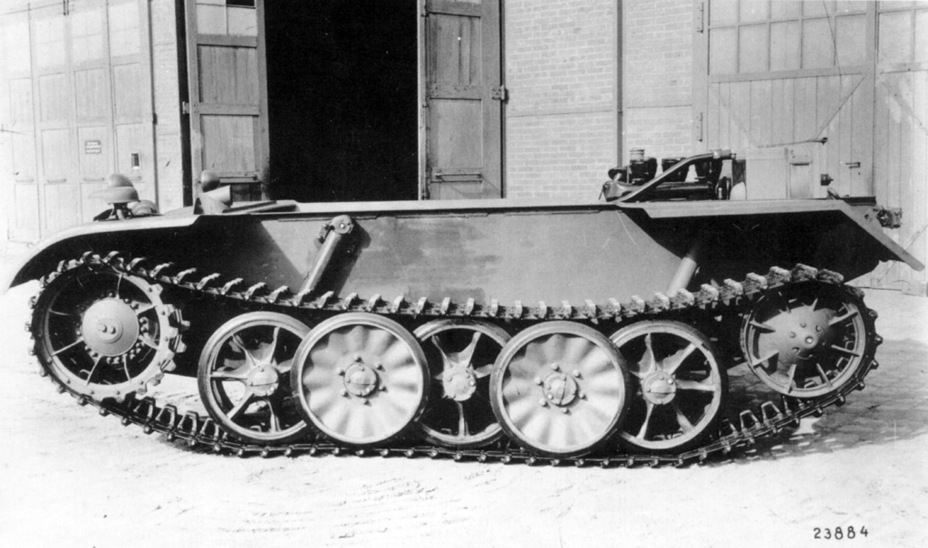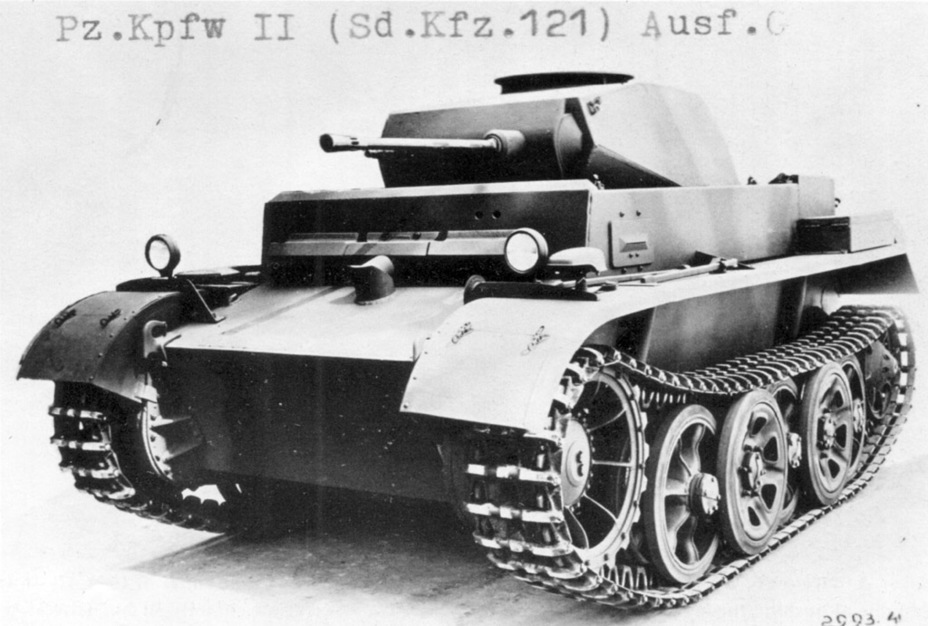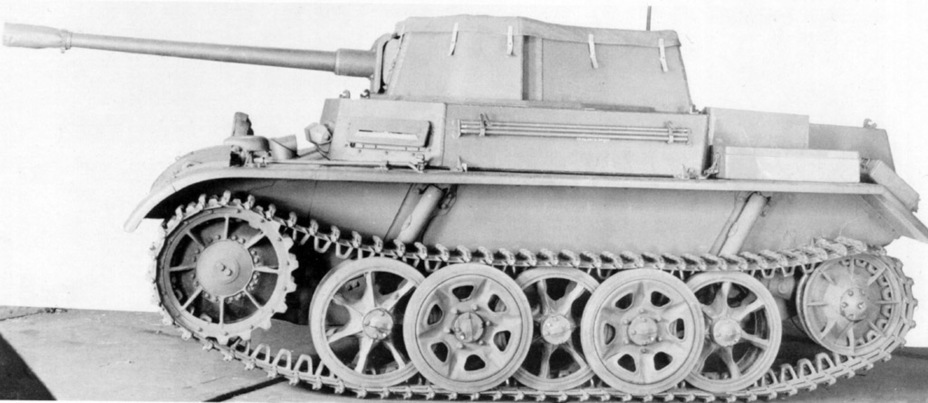The idea of replacing the La.S.100, or the PzII, with a superior vehicle was born in January of 1937. The result was the La.S.138, otherwise known as the PzII Ausf. D and Ausf. E, created by MAN and the famous tank designer Heinrich Kniepkamp. The tank had a progressive torsion bar suspension, but its service did not last for long. It was clear that the story of the La.S.138 was developing poorly by the summer of 1938, before the tank even entered production. The result of this understanding was the development of another vehicle, which was supposed to replace both the La.S.100 and La.S.138. This is how the light tank Pz.Kpfw.II Ausf.G and the tank destroyer Pz.Sfl.Ic turned out.
VK 6.01 for three
On June 18th, 1938, In 6 (Inspekteur für Heeresmotorisierung, Inspection of Motorized Forces) initiated work on a new tank. In the new system of indexes that Kniepkamp took part in creating, the project was dubbed VK 9.01 (fully tracked, 9 ton weight class, type 1) in October of 1938. The developer remained the same. Like with previous projects, MAN designed the chassis and Daimler-Benz worked on the turret platform and turret. The general concept of the PzII family also remained the same. The vehicle held three people: the commander, also serving as the gunner and loader, was in the turret. The driver and radio operator were located in the forward compartment. Like in the La.S.138, they sat shoulder to shoulder.

The armament was also identical: a 20 mm autocannon and an MG 34 coaxial machinegun. However, there was a difference here: a vertical stabilizer, which improved accuracy on the move. The armour was on the level of the La.S.183: 30 mm in the front and 14.5 mm along the sides. This meant that the vehicle was protected from 20 mm autocannons from the front and rifle caliber bullets from the sides.
The VK 9.01 was developed in tight cooperation with Kniepkamp, which had a direct influence on its design. It looks like the designer didn't reinvent the wheel and reused what was available. This was the light VK 3 t tank, which was designed by Krauss-Maffei and Kniepkamp starting in October of 1937. The project evolved into the VK 6.01 by the summer of 1939. This design was used as the foundation.
Even the naked eye can see how similar these two tanks are. The further the design work proceeded, the more obvious it became. Essentially, this was the same VK 6.01, but larger, especially width-wise. The need to fit three people instead of two into the tank meant that it had to be wider. The turret was also very similar, only with different dimensions and armament. It's not known if Kniepkamp tried to install tracks with rubber pads similar to those used in halftracks on the VK 9.01, like he did on the VK 6.01.
A commission from the 6th Department of Armament arrived at the MAN factory in Nuremberg on October 11th, 1938, where they was shown a wooden model of the tank. A meeting was held on the same day, which was attended by leading MAN engineers Friedrich Rif and Paul Wibike. At the start of his career, when Kniepkamp was working at MAN, he was Wibike's subordinate. The main objective of this visit was, of course, to view the model. Kniepkamp and other representatives of the 6th Department were worried about the dimensions of the fighting compartment. Hardly any equipment was installed, and it was already very small.

Work continued, and the VK 9.01 and VK 6.01 became more and more similar, both externally and technically. Both received the 150 hp Maybach HL 45 engine and an 8-speed semiautomatic Maybach SRG 15319 gearbox. The VK 9.01 had a three stage LG 45 turning mechanism. Like on the VK 6.01, it was controlled via steering wheel. The suspension was similar to the one used on its little brother, and even the diameter of the road wheels was the same: 650 mm. The design of the road wheels was also very similar.
After improvements to the initial design, MAN received a contract for five experimental VK 9.01 chassis. In 6 also signed a contract for 30 pilot VK 9.01 tanks, increased to 75 in July of 1939. Simultaneously, a contract for the same number of turrets and turret platforms was signed with Daimler-Benz.

By proud tradition, these plans were altered soon after they were confirmed. In August-September of 1939, a new variant of the tank called VK 9.02 appeared. It had a modernized LG 45 L turning mechanism, later renamed to LGL 15319. According to new plans, the first 30 tanks of the pilot batch would be called VK 9.01 and be equipped with LGR 15319 turning mechanisms, the rest would be VK 9.02s. The first 5 VK 9.01 chassis were planned for July of 1940, 10 more in August, 10 in September, and 5 in October.
However, it was clear that these deadlines would change in July of 1939. The completion of the chassis was moved to November of 1940, and the finished tanks were not expected until November of 1941. All that could be done in 1939 was the completion of one experimental VK 9.01 chassis in December. Since the fate of the tank was predictable, it was decided that it would be replaced with the PzII Ausf. F equipped with a stabilizer in case of failure. This is what happened in the end, except the PzII Ausf. F never received the stabilizer. At a meeting held on April 25th, the VK 9.01 was referred to as Pz.Kpfw.II n.A.
Where daydreams lead
The second half of 1940 was full of further changes to the tank and production plans. For instance, on July 25th the number of LGR 15319 equipped tanks was reduced to 20, and the remaining 55 would receive the LGL 15139 turning mechanism. Production plans were changed in November: 45 VK 9.01 chassis were now expected from MAN between May and September of 1941.

Meanwhile, all signs pointed to the fact that the production run of the VK 9.01 would be limited to its pilot batch. On June 22nd, 1940, In 6 put out an order for a new 10 ton class light tank with improved speed characteristics and 20 mm armour on its sides. The vehicle was indexed VK 9.03. The increased weight would be compensated by a 180 hp Maybach HL 66 P engine. A larger engine triggered the redesign of the engine compartment. It became a little larger. The armament initially remained the same as on the VK 9.01.
MAN prepared the first calculations for the VK 9.03 projects in July of 1940. The turning mechanism was the same as on the VK 9.01, but the gearbox was replaced with the Maybach VG 20417. Further development was dedicated to reinforcing the suspension. The length of the contact surface increased to 2.08 meters and the width of the tracks from 300 to 360 mm.
The Germans had many plans for the modernized vehicle. According to the tank development program, approved on May 30th, 1941, 2592 VK 9.03 tanks were expected for initial saturation of the tank forces, and subsequent orders looked even more impressive: 8111 units. It is likely that the vehicle would have been modernized. The indexes VK 9.04 and VK 9.05 were already present in documents.

While debates about the future VK 9.03 raged on, the fate of the VK 9.01 was grim. Yet another replacement of gearboxes took place in April of 1941. 5 tanks would be built with the Maybach OG 20417, 5 more with the ZF SMG 50. The first chassis of the Pz.Kpfw.II n.A. was built that month, and the number of chassis reached 15 by mid-August. The result of the new gearboxes was poor: 2 of the Maybach OG 20417 and 5 ZF SMG 50 broke during trials at Kummersdorf.

Various corrections to the VK 9.03 continued. As a result, the tank remained on paper by the end of 1941. For instance, the idea of making a more powerful gun based on the 28 mm Geschütz 8202 (also known as the 2.8 cm sPzB 41) anti-tank rifle. The appearance of such a project was predictable, since the 20 mm KwK 30 and KwK 38 were no longer sufficient. The new gun would be called 2.8 cm KwK 41, and later, due to delays, the name was changed to 2.8 cm KwK 42.

Another change to the yet-unborn VK 9.03 was made in December of 1941. In addition to the single man turret, the Heereswaffenamt (Directorate of Armament of the Land Forces) ordered the development of an alternative variant with a two man turret. Daimler-Benz was developing this turret for the VK 13.01 reconnaissance tank, better known as the Pz.Sp.Wg.II Luchs. Since there were already 3 tanks under the index VK 9, they received additional indexes. The VK 9.01 was called PzII Ausf. G, the VK 9.03 was called PzII Ausf. H, and the version with two man turret received the name PzII Ausf. M. The two man turret variant would weigh 10.5 tons, and its mobility and protection would remain at the level of the VK 9.03.
Another potential replacement could have touched the gearbox. A diesel engine was discussed in February of 1942. This engine, with a power of 180 hp, was created at MAN in 1939. In March 1942, the idea of installing a 400 hp Maybach HL 100 engine into the VK 9.05 was considered. The issue of replacing the gearbox and turning mechanisms with those that BMM designed for the Pz38(t) n.A. tank was also discussed.

All of these dreams were ruthlessly shattered on March 27th, 1942. MAN received a letter from General Emil Leeb, the head of the Heereswaffenamt. The brass was tired of these designers' games, especially since work on the VK 9.03 has not yet progressed past a handful of half-finished chassis. With the VK 13.03 on hand, a further development of the VK 13.01, the development of another similar tank was excessive. Work on the VK 9.03 and its derivatives ceased.

Unlike its prospective replacement, fate smiled on the VK 9.01. However, the plans for production kept changing. In addition, there were delays in production of the turrets and turret platforms at the Daimler-Benz Wrk 40 factory in Berlin. The first sets of steel did not arrive until the fall of 1941. In total, MAN built no fewer than 45 PzII Ausf. G chassis, and Daimler-Benz supplied 60 sets of turrets and turret platforms. It is not known how many of these became fully fledged tanks. There is also no information about how many tanks received what kind of gearbox. As mentioned above, three types of gearboxes were used.

The final variant of the VK 9.01 fell within the requirements that it was built to. The mass grew to 10.5 tons, but the mobility did not suffer much. The top speed on a highway was 67 kph, but it was limited to 65 kph. Overall, this was a decent reconnaissance tank. However, the VK 13.03, a much more suitable candidate for this role, entered trials in the spring of 1942. It's not surprising that production of the VK 9.01 did not progress past an incomplete pilot batch. MAN was also taking on more and more work on the Panther tank, and there was simply no time for light reconnaissance tanks.

The combat history of the PzII Ausf. G is a bit question mark. It is known that the 15th Tank Division was pegged as the first unit to receive these tanks. However, these plans were made in February of 1941, before the first pilot vehicles left MAN. Nevertheless, the tanks built in August of 1941 were painted in RAL 8000, the colour of Africa Corps tanks. It's not known what happened to them after that. Most tanks likely ended up in training units.
Nevertheless, claims that the PzII Ausf. G never saw combat are incorrect. Photographs periodically surface in internet auctions that demonstrate that these tanks ended up on the Eastern Front. However, it has not yet been possible to establish the time these photos were taken or what unit the tanks belonged to. Many white spots exist in the history of the PzII Ausf. G that have yet to be filled.
Quick Tank Destroyer
Many permutations of the VK 9.01 design did not prohibit the Germans from considering its chassis for the role of an SPG in the summer of 1940. The result of this was the use of Panzerjager I tank destroyers in the French campaign. Overall, the vehicles performed well, but it was clear that the PzI Ausf. B was not the ideal choice of a chassis. The 50 mm Pak 38 gun was nearing the final stages of development, and it was superior to the Czechoslovakian 47 mm PUV vz.36. More importantly, it was produced in Germany. It is not surprising that, on July 5th of 1940, In 6, and later the 6th Department of Armament, ordered Rheinmetall-Borsig to develop a tank destroyer that used the chassis of the VK 9.01.

The design of the vehicle called Pz.Sfl.Ic was finalized towards the end of the spring of 1941. Even though the VK 9.03 was considered more promising at that point, Rheinmetall-Borsig, which tasked Alkett with the development, decided to go with the VK 9.01. Considering that this chassis was actually built in metal, this was a reasonable choice.
The chassis remained nearly unchanged, but the side armour was increased to 20 mm with applique armour. An altered turret platform was used. It became wider, since a fighting compartment for two men was planned instead of the one man turret. Instead of a turret, an immobile open-top casemate was used. A slightly altered 50 mm Pak 38 was installed in the front. In part, its recoil mechanisms were redesigned to take up less room in the fighting compartment. A movable gun shield covered the crew from the front and partially from the sides.
The vehicle was not incredibly roomy, but it was more promising than the Panzerjager I. Aside from improved armament, the Pz.Sfl.Ic had increased mobility, and fair protection for its vehicle class. At the very least, high caliber machineguns would not be a fatal threat.

The Germans had great plans for the Pz.Sfl.Ic. The total production run would be for 2028 units. Unfortunately, the changing requirements and various improvements made the production of even the VK 9.03 more and more distant. The SPG was a hostage in this situation.
Nevertheless, two experimental vehicles were built in the fall of 1941, both using armour steel. The Pz.Sfl.Ic program was killed by two factors. The first was that the VK 9.03 program died in March of 1942. The second was that the 75 mm Pak 40 entered production, which was much more powerful than the Pak 38. The VK 9.01 chassis could not mount it. Knowing this, In 6 launched a program to design a tank destroyer with a 75 mm gun on the chassis of the La.S.138, better known as the Marder II. Nevertheless, the Pz.Sfl.Ic reached the battlefield. Both experimental vehicles were sent to the 3rd battery of the 559th Tank Destroyer Battalion. They fought on the Eastern Front as a part of this unit. By August 20th, 1942, one of them was still combat ready.
Translated by Peter Samsonov. Read more interesting tank articles on his blog Tank Archives.







